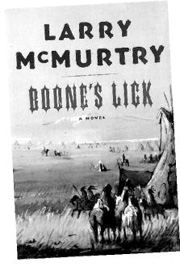AMERICANS HAVE ALWAYS been a wandering folk. It’s how our country was settled in the first place, by people who just couldn’t stop hankering after the next wide-open space. One of the most revealing tales of Daniel Boone comes from the very early 19th century, after he moved his family to Missouri. Seems a traveler asked the aging frontier hero why he’d left his previous home in Kentucky. Boone remarked that he had felt cramped by the presence of his neighbors but irritably added that even in Missouri, “I am too much crowded.” Naturally, the traveler wanted to know how close his nearest residents lived and was stunned by Boone’s answer: only 20 miles!
Boone’s Lick
by Larry McMurtry (Simon & Schuster, $24)
This itch to move on has become a principal theme for Texas writer Larry McMurtry, informing not only most of the eight historical novels he’s published since his Pulitzer Prize-winning Lonesome Dove (1985) but even his contemporary works. So it should come as no surprise that Boone’s Lick, this author’s latest (and, at 288 pages, shortest) Western adventure is organized around a cross-country journey. What is remarkable, however, is how little interest McMurtry manages to drum up over so many fictionalized miles.
Things start out well enough. We’re introduced into the environs of tiny Boone’s Lick, Missouri, where three generations of the Cecil clan are trying to scratch out a living shortly after the Civil War—a goal made more difficult by the predations of local ruffians. As tensions build, the town’s sheriff recruits leisure-loving Seth Cecil, his nephews G.T. and Shay (the latter of whom, at 15, serves as this book’s narrator), and the not-yet-legendary James Butler “Wild Bill” Hickok to help him apprehend the miscreants. But from the beginning, there are problems (matriarch Mary Margaret Cecil shotguns the sheriff’s horse out from under him as he approaches her doorstep, claiming she thought it was a potentially tasty elk), and it’s all downhill from there, as the posse is ambushed by the very men they’re hunting. It’s a classically light-hearted McMurtry scene, the good guys jawboning calmly at one another (“Do you see anyone you particularly want to shoot, Seth?” Mr. Hickok asked) as they endeavor—with some unanticipated and comic assistance from a vexed bear—to stem an assault that might have inspired a Keystone Kops routine.
AFTER THAT, THOUGH, this tale begins to lose vitality and cohesion. The headstrong Mary Margaret—tired of being solely responsible for her family while her husband (Seth’s brother, Dick) spends all but a couple of nights away each year, hauling freight along the Oregon Trail—determines to head west, just so she can tell Dick face to face that she’s leaving him for good. And with her, she’s taking her four children, her ailing father, and Seth, whom she has grown to love during Dick’s absence. Much of what follows could be predicted: The Cecils endure transportation and weather hardships, encounter Native Americans to whom they must pay tributes for peaceful passage over the monotonous plains, and eventually learn that Dick Cecil has more keeping him out west than simply business. Along the way, they add members to their troop—a blithely barefooted priest, Father Villy, and Charlie Seven Days, a Shoshone sent by the famous native guide Sacagawea to look for her missing son—who reinforce McMurtry’s reputation for concocting memorable oddball characters and imaginatively interpreting authentic historic figures. Yet the most engaging players in this drama remain Seth, whose grousing doesn’t quite hide his rich spirit or big heart, and Mary Margaret, a woman as resourceful (if not as fully drawn) as any of McMurtry’s many female protagonists.
For a writer as skilled as McMurtry, it’s disappointing to find the plot of Boone’s Lick so ragged. Outsiders come and go from the Cecil family circle, never to be seen again—and having no impact on the rest of the tale. The reunion between Mary Margaret and errant Dick produces few fireworks and no poignancy. And while it provides ample action, a late-chapter Sioux attack on Wyoming’s Fort Phil Kearny—based on a real-life massacre from 1866—is inadequately presaged and adds nothing to our understanding of the novel’s main characters. There’s the sense throughout Boone’s Lick of its being a sort of literary yard sale, McMurtry laying out a selection of pretty attractive ideas that don’t necessarily fit together. Perhaps next time he’ll bring out more of the good stuff we know he’s left behind.








